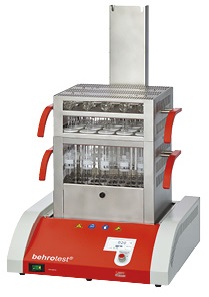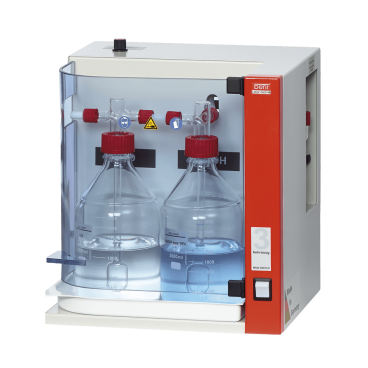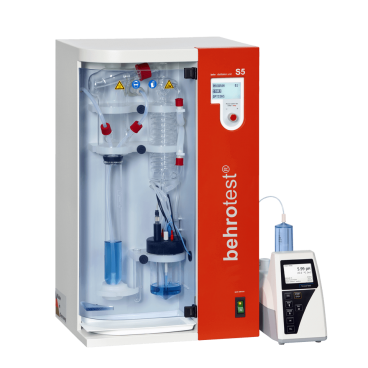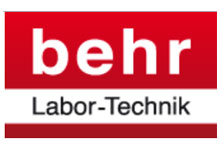The process determines nitrogen and proteins in organic materials. In the Kjeldahl method, the boiling point of sulfuric acid of 337 degrees Celsius is increased by means of catalysts. Approx. 380 ° C is the optimum decomposition temperature for organic materials in sulfuric acid. The protein content is determined by multiplying the analytically determined nitrogen content by a factor of 6.25, in the case of wheat and semolina flour by a factor of 5.7. The nitrogen content is determined by the Kjeldahl method in 4 stages.
Blocking systems with high-quality corrosion-resistant block housing made of stainless steel.
Complete systems with decomposition vessels, frame and exhaust hood.
With 8, 12 or 20 sampling points for standard Kjeldahl digestion vessels with a volume of 250 ml.
- High performance heating and exhaust hood with exhaust collector.
- The digestion progress is observed through the detachable sight door on the rack.
- One-button operation for easy and fast programming.
- Menu guidance in national language.
- 10 freely configurable programs for block temperature and digestion time.
- Applications can be stored.
- USB interface.
The included Windows software allows the user to transfer application-specific time / temperature profiles via the interface bidirectionally between one or more devices and a PC. A library with common applications is already included on the CD. Via the RS232 interface, temperature data can also be transferred from the device to the PC during operation. The user can save them and print them as graphics.
Sturdy and robust construction. Both the block housing as well as the frame for the digestion vessels
and the extraction hood are made of acid-resistant, stainless steel. Complete systems with decomposition vessels, frame and exhaust hood.
Behrosog neutralizer
The two-stage behrosog process extraction system (neutraliser) - pre-separator plus safety stage - completely keeps all acid fumes away from the environment. Compact process suction system for the suction and neutralization of aggressive acid vapors, mainly from the Kjeldahl digestion for nitrogen determination. An upstream two-stage pre-separator ishes out the toxins. The process suction system is equipped with a vacuum pump 40 l / min. A connection to the water supply is not necessary.
- Efficient operating costs
- Continuously adjustable suction flow
- Both cleaning stages (condensation and neutralization stage) prevent the emission of toxins to the environment
Optionally, the additional cooling system ACS for behrosog 3, consisting of stand, bottle and cooler, can be connected to the system.
Water steam distiller with automatic addition
Behr water steam distributors are not only powerful and reliable
partners in the laboratory day. A major concern in the development and design
of the devices was also the safety of the user.
- Exemplary security and reliability
- Robust and insensitive housing made of polyurethane
- Distillation time approx. 3 min per sample
- Detection limit 0.2 mg N
- Recovery rate> 99.5%
- Reproducibility ± 1%
- Steam output adjustable (40% - 100%)
- Particularly simple, menu-driven operation via a single control element (behr one-button operation)
- Programmable response time
- Programmable distillation time
- USB interface
- Level monitoring for the canister set
- Practical quick-release device, which the user can also use "with the left"
Behr steam distillation units of the S series are the ideal addition to the behr Kjeldahl digestion systems. Depending on requirements, the user can choose between five automatic steam distillation units. These are identical in the basic configuration, but differ in operating convenience and degree of automation. The top model behr S5 is prepared to work with an external titrator.
The included Windows software allows the user to transfer application-specific distillation parameters bidirectionally between one or more devices and a PC via the USB interface. A library with common applications is already included on the CD.
Manual titration station
The hand-held station STI consists of:
- A burette with digital display and
- A magnetic stirrer with a matching holder for an Erlenmeyer piston
A screen serves as a neutral background and allows the user to precisely visualize the color change at the end of the titration. Thus, it always performs its titrations under similar optical conditions. This improves the accuracy and reproducibility of the results.
This is also due to the exact positioning of the vessel in the holder on the top of the magnetic stirrer. The angled wings of the screen additionally protect from the side glare.





